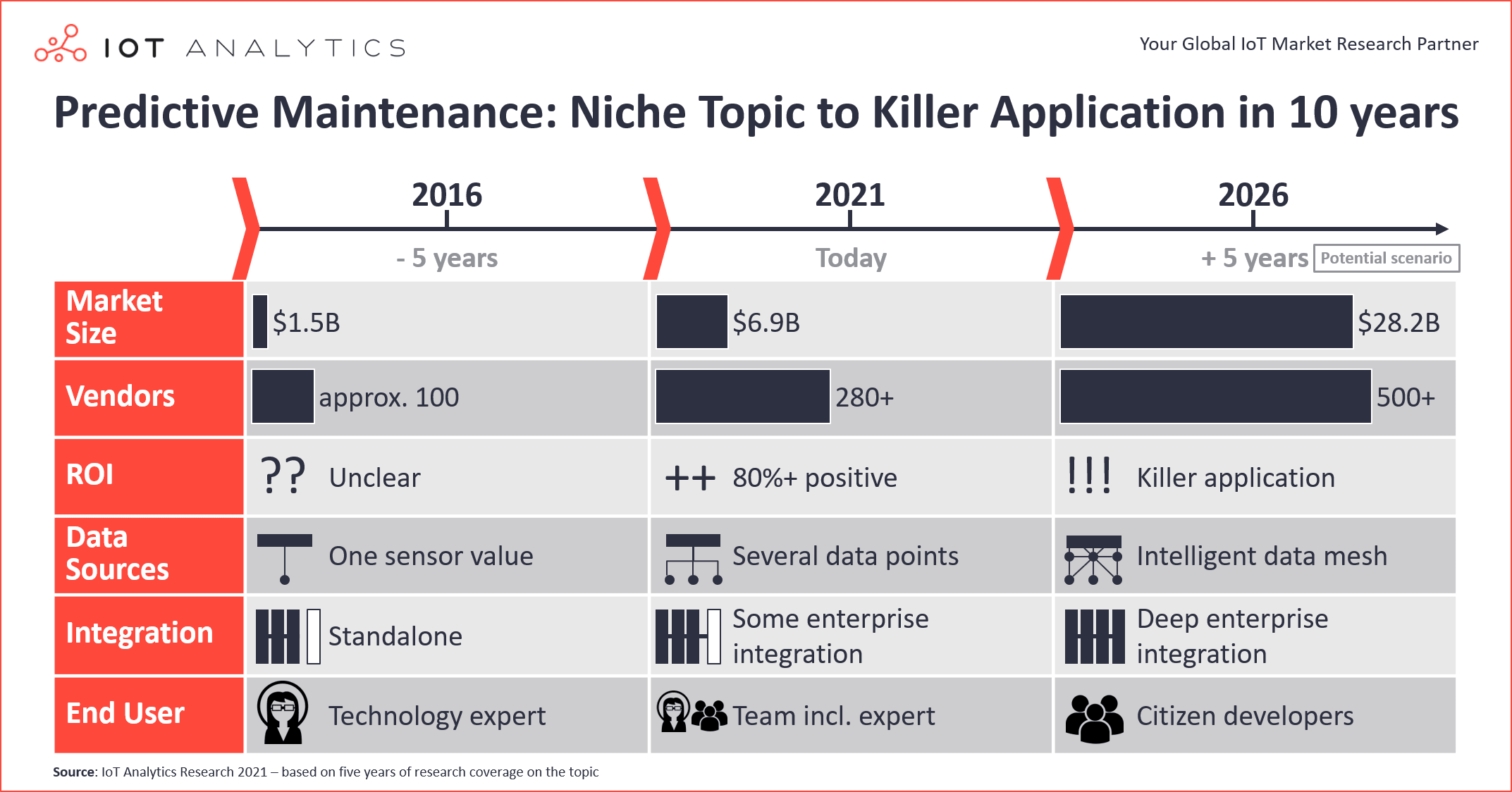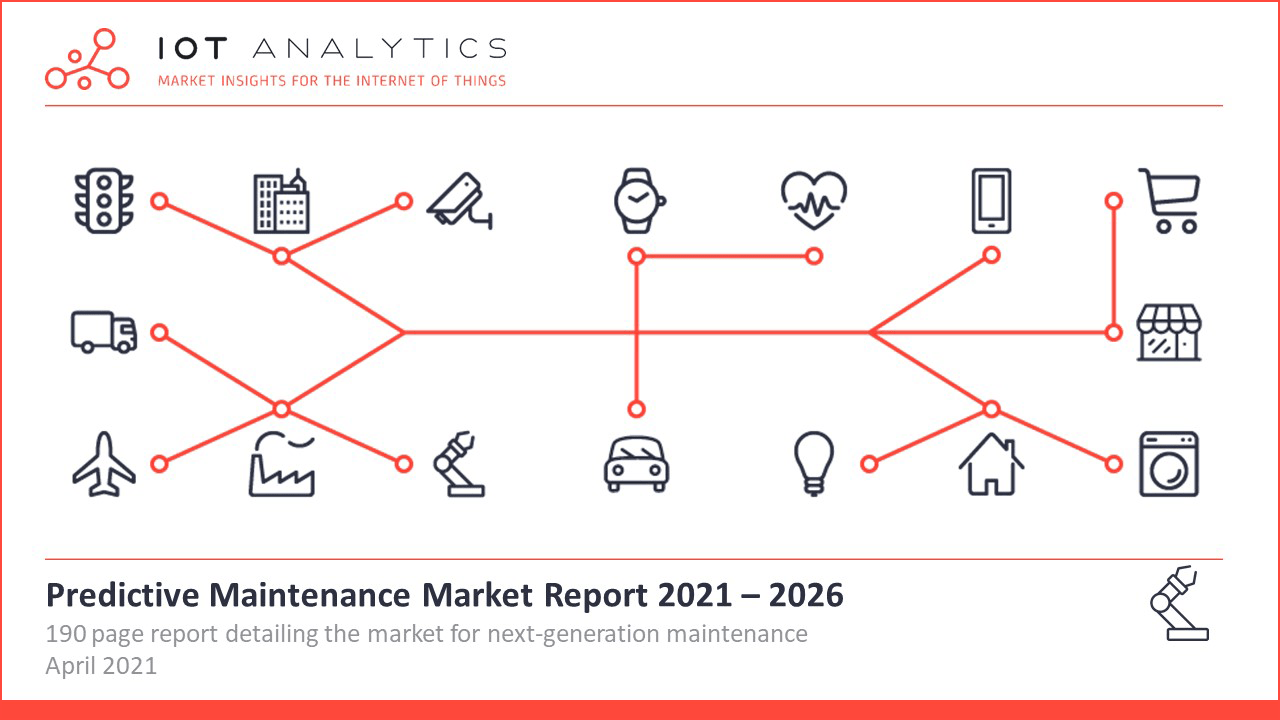
In short
- In just five years, predictive maintenance has moved from an uncertain, standalone niche use case to a fast-growing, high return on investment (ROI) application that is truly delivering value to users.
- These developments are an indication of the power of the Internet of Things (IoT) and artificial intelligence (AI), and the market is still in its infancy.
- A new IoT Analytics report estimates that the $6.9 billion predictive maintenance market will reach $28.2 billion by 2026.
Why it matters?
- This research is a wake-up call to those that claim IoT is failing.
- For companies that own industrial assets or sell equipment, now is the time to invest in predictive maintenance-type solutions.
- Enterprise technology firms need to prepare to integrate predictive maintenance solutions into their offerings.
In 2015, when IoT Analytics initiated research coverage on the topic of IoT-driven predictive maintenance, the market was almost non-existent. Knud Lasse Lueth, CEO at IoT Analytics, remembers, “In the spring of 2016, we attended an industry-leading maintenance conference in Dortmund, Germany, full of hopes to discuss how companies were embracing the new AI-enabled paradigm of predictive maintenance. We were bitterly disappointed. Not a single exhibitor was talking about predictive maintenance. In the end, I managed to have one meaningful discussion with a researcher from Fraunhofer Institute and that was it [aside from] a few discussions with folks that had perfected condition-monitoring on rotating equipment for the past 30 years.”
A lot has happened since 2016. Our research in 2021 shows that predictive maintenance has clearly evolved from the rather static condition-monitoring approach. It has become a viable IoT application that is delivering overwhelmingly positive ROI. Several technological developments have contributed to the rapid market expansion—notably, a simplified process of connecting IoT assets, major advancements in cloud services, and improvements in the accessibility of machine learning (ML)/data science frameworks.
Based on more than five years of coverage on the topic, IoT Analytics has identified six key aspects that depict the evolution of the predictive maintenance market from a niche topic to a high ROI application and offer an outlook for the next five years.
Predictive maintenance market size—from 1 billion to 28 billion in 10 years
In 2016, the global predictive maintenance market (hardware, software, and services) was valued at $1.5 billion, considerably smaller than the condition-based maintenance market. The dominant maintenance paradigm was preventive and time-based rather than predictive and based on actual equipment conditions. Many companies performed maintenance actions at regular and frequent intervals to lessen the likelihood of costly failures.
Today, the shift from preventive to condition-based and predictive (in some cases already prescriptive) maintenance is in full swing. Predictive maintenance in 2021 is a $6.9 billion market, according to our latest analysis on the topic, titled Predictive Maintenance Market Report 2021-2026. The market is driven by advancements in sensors, data science, and AI technologies and a decrease in IoT infrastructure costs. We have witnessed an increase in start-ups, merger and acquisition activity, and published case studies within the last couple of years.
Going forward, we estimate that the predictive maintenance market will see a strong recovery post-COVID-19 alongside a heightened and broad interest in digital topics in general (of which predictive maintenance is a part). In our estimation, the predictive maintenance market will grow at a 31% compound annual growth rate to reach $28.2 billion by 2026. More and more companies will realize the potential benefits that predictive maintenance solutions offer during uncertain times (e.g., saving time and maintenance costs and improving production capacity). The key performance indicator to watch is the reduction of unplanned operational equipment standstills due to predictive maintenance. Today’s predictive maintenance projects show that, in many industries, the vision of zero unplanned downtime might be achievable. On a global scale, the total cost savings of such an achievement would easily surpass the $1 trillion mark.
Predictive maintenance vendors—from a few dozen to several hundreds
Accompanying overall growth, the predictive maintenance market has seen a steady increase in vendors catering to this market with specific solutions.
When we first analyzed the vendor landscape in 2016, we observed close to 100 companies competing in the field, with only a few dozen entirely dedicated to predictive maintenance.
Today, that number has increased greatly. In our latest research, we have come across more than 280 solution providers globally. The growth is fueled by a large number of start-ups that have recently entered the topic, notably in the analytics part of the technology stack, helping users make sense of their ever-growing and scattered data. Established providers like GE, PTC, Cisco, ABB, or Siemens have also entered the market in the last five years, in many cases with the help of smaller acquisitions (e.g., ABB–Cassantec).
With the market expected to expand quickly and companies seeking support in making accurate predictions using their numerous data sources and in connecting predictive maintenance (PdM) solutions to their core business systems, there is a lot of room for more vendors to enter the market. We do not believe that it is unreasonable to expect the number of vendors to exceed 500 in the next five years.
Predictive maintenance return on investment—from unclear benefit to must-have killer application
In 2016, unclear ROI was one of the top three barriers for IoT implementations (including PdM), according to a Bain survey of ~170 executives at IoT and analytics vendors and over 500 IoT customers. Security concerns and the difficulty of integrating IoT solutions with existing information technology (IT) and operational technology (OT) were also top concerns. Two years later, in 2018, tech vendors had not made much progress in addressing the latter two, but it had become clear that IoT projects could deliver definite ROI. Customers’ higher confidence in positive ROI projections can most likely be attributed to increasing satisfaction with earlier industrial IoT use case implementations, as shown in the research.
The data we have in 2021 shows an entirely different picture than the data from 2016. An IoT Analytics survey of ~100 senior IT and OT managers from the industrial sector (which is discussed in-depth as part of the predictive maintenance market report 2021) observed that predictive maintenance implementations yielded a positive ROI in 83% of the cases and that 45% of those reported amortization in less than a year. This data demonstrates how attractive the investment has become in recent years.
In the future, as PdM solution sophistication and ease of implementation increase, we expect predictive maintenance ROI to increase even further. It is not unreasonable to assume that predictive maintenance will be a must-have for industrial organizations of all kinds, making it the killer use case at the intersection of the Internet of Things and artificial intelligence.
Predictive maintenance data sources—from one sensor value to an intelligent data mesh
The predictive maintenance implementations we researched in 2016 typically relied on a limited number of data sources, often using just one sensor value (e.g., vibration or temperature) to develop their predictive maintenance solutions.
While researching our 2021 report, we realized that the number of available data sources has increased considerably in recent predictive maintenance projects. In total, there are 11 classes of data sources, two examples of which are data from existing sensors or data from the controllers. Most projects still only use a small selection of those sources, but as more sources are tapped, the average precision of the predictions increases.
Today, it is becoming more common to deploy hybrid modeling approaches that leverage domain expertise, virtual sensors, and augmented data. AspenTech and PARC are two vendors embracing hybrid modeling approaches. In September 2020, AspenTech revealed that it has been working with over 60 companies to develop and test Aspen Hybrid Models that combine physics-based models with ML data science knowledge to enhance the prediction accuracy of PdM solutions. PARC also recently showcased its MOXI Industrial Internet of Things system analytics, which leverages a hybrid approach.
In the future, as more machine and process data accumulate and data lakes/libraries of highly contextualized machine datasets are created, we expect that companies will have an even richer pool of data to tap into to deploy solutions. This will prove especially valuable for equipment that rarely fails, as the existing past failure data is not sufficient for good future predictions.
Not only is the quantity of data sources increasing but also the quality. Tomorrow’s data collection devices will be increasingly built with higher computing capabilities (i.e., edge computing). IoT Analytics expects that sensing devices will also enable algorithms to run at the point where data is collected, thereby reducing response latency and increasing the benefits offered by a solution. Companies like STMicroelectronics have already introduced smart sensor nodes that can perform both sensing and analytical processing.
Predictive maintenance solution integration—from standalone to deeply ingrained within the enterprise
“In the future, predictive maintenance will likely be a standard part of existing enterprise software or tightly integrated with most major systems.”
In 2016, many predictive maintenance solutions were standalone, separated from other enterprise applications. An IoT Analytics survey of technology providers found that interoperability between the different system components was regarded as the main challenge for most IoT-based industrial analytics projects. Respondents specifically called out missing standards: 78% of them labeled this aspect challenging or very challenging. The same study also showed that end users regarded current PdM solutions as lacking usability in terms of integration with existing processes (e.g., maintenance work orders, spare parts supply, and repair assistance tools).
In 2021, integration with other enterprise systems has become commonplace. A 2020 survey that is discussed in depth in the report shows that the clear majority of predictive maintenance solutions are integrated with other business systems, such as enterprise resource planning (ERP) or computerized maintenance management system (CMMS) solutions. It has become standard for predictive maintenance vendors to provide integration with different sensing technologies, control systems, and other enterprise or maintenance software. For instance, Litmus Automation offers third-party integration with any industrial asset, such as a programmable logic controller, distributed control system, supervisory control and data acquisition system, historian, sensor, or ERP.
In the future, predictive maintenance will likely be a standard part of existing enterprise software or tightly integrated with most major systems. CMMS/asset management software vendors have already started to integrate predictive maintenance features/solutions as add-ons to their existing enterprise software solutions (e.g., IBM’s Maximo asset management suite), and they see these developments as crucial.
Predictive maintenance end user profile—from technology expert to citizen developer
In 2016, it was regarded as essential that companies had a data scientist team with use case-specific know-how so that they could adapt digital twin data, data models, and algorithms/libraries to their specific predictive maintenance needs (source).
In 2021, there is still a need for data scientists in PdM solution development, but a clear shift is occurring. In the last couple of years, there has been a movement towards a.) the increased use of automated predictive maintenance software and b.) the development of “low-code/no-code” solutions. Predictive maintenance providers like Augury, for example, automate the insights generation process by providing their customers with a “data science in a box” type solution. The promise to users is that they get results from day one and are automatically supplied with prescriptive corrective actions. automatically extracting machine data insights (and prescribe corrective actions) to provide end users with […]”. Many other PdM vendors are adding similar features that empower non-data scientists to develop and deploy algorithms to realize predictive maintenance. For instance, C3 AI’s Ex Machina offering “enables anyone to develop, scale, and apply AI insights without writing code.”
At IoT Analytics, we estimate that in the next five years, the current proliferation of low-code/no-code and automated PdM software solutions will advance, enabling non-tech experts (so-called citizen developers) to realize PdM without significant domain expertise or programming skills. Similarly, we believe it is also possible that non-tech experts could install PdM sensing infrastructure without the required technical expertise in some instances. This latter capability is already being advanced within the predictive maintenance market by companies like Augury, Amazon, and Nanoprecise. In a 2020 presentation at the AWS re:Invent conference, Magnus Akesson, CIO at GE Gas Power, said that installing Amazon’s Monitron predictive maintenance offering is “as easy as setting up your iPhone”.
More information and further reading
Are you interested in learning more about Predictive Maintenance?
The “Predictive Maintenance Market Report 2021-2026” is a comprehensive 183-page report assessing the Predictive Maintenance market. It also includes a comprehensive summary of results on two surveys of industrial IoT end users, a list of 10 case studies, a technology overview, a vendor landscape with ~280 firms, and a discussion of seven current trends and two challenges. The report is part of IoT Analytics’ ongoing coverage of industrial and software/analytics topics (Industrial IoT Workstream).

This report provides answers to the following questions (among others):
- What is Predictive Maintenance?
- How big is the Predictive Maintenance market today and how fast is it growing?
- Which types of technologies are used for Predictive Maintenance?
- What are examples of Predictive Maintenance vendors and their strategies to achieve zero downtime?
- What is the current Predictive Maintenance penetration rate, planned investments and implementation best-practices?
And more …
Sample:
The sample of the report gives you a holistic overview of the available analysis (including the outline and key slides). The sample also provides additional context for the topic and describes the methodology of the analysis. You can download the sample here:
Related articles
You may also be interested in the following recent articles:
- The 7 Most Demanded IoT System Integration Services
- What CEOs talked about in Q1 2021: Vaccines, Sustainability, Semiconductors
Are you interested in continued IoT coverage and updates?
Subscribe to our newsletter and follow us on LinkedIn and Twitter to stay up-to-date on the latest trends shaping the IoT markets. For complete enterprise IoT coverage with access to all of IoT Analytics’ paid content & reports including dedicated analyst time check out Enterprise subscription.


